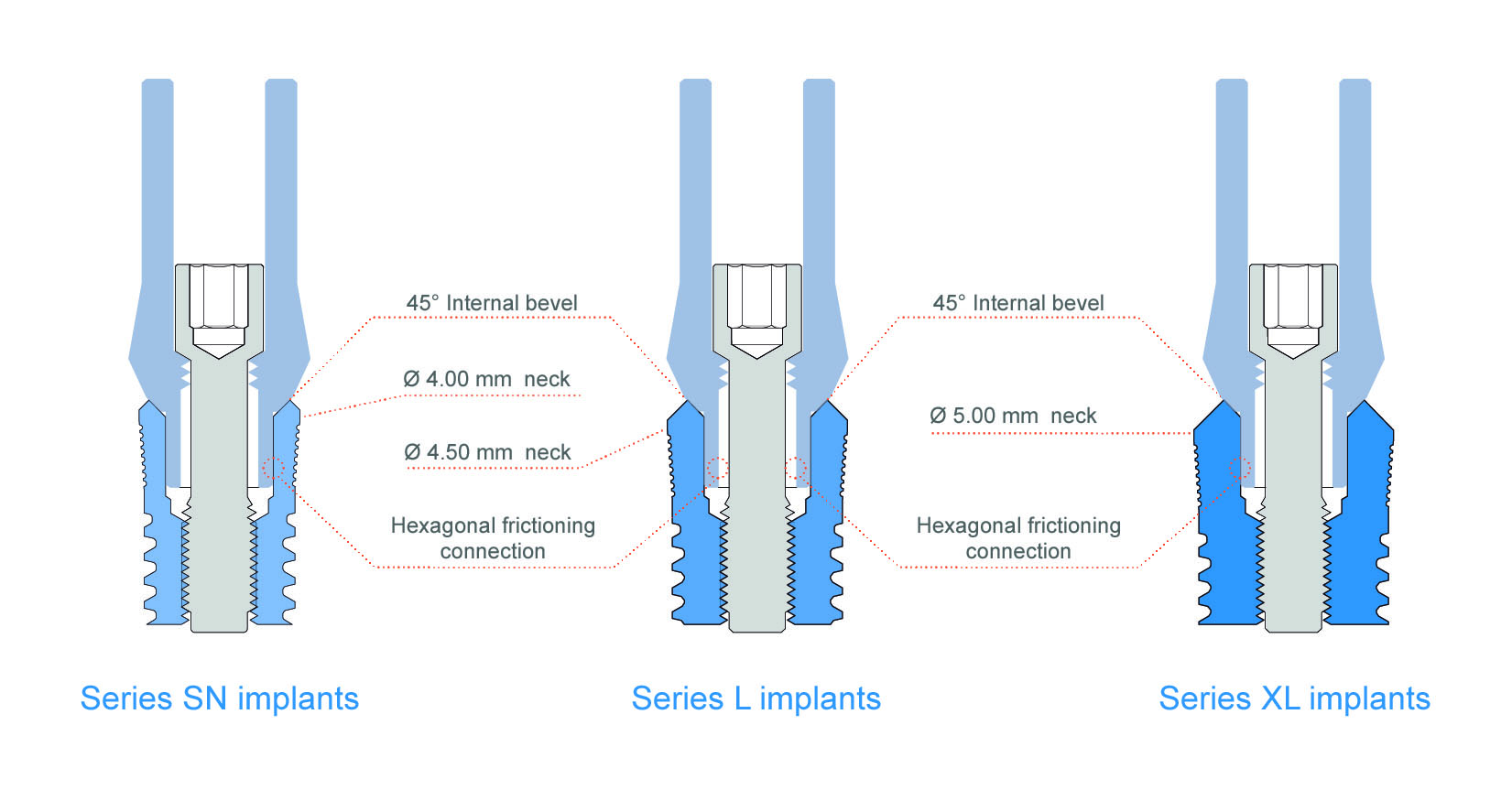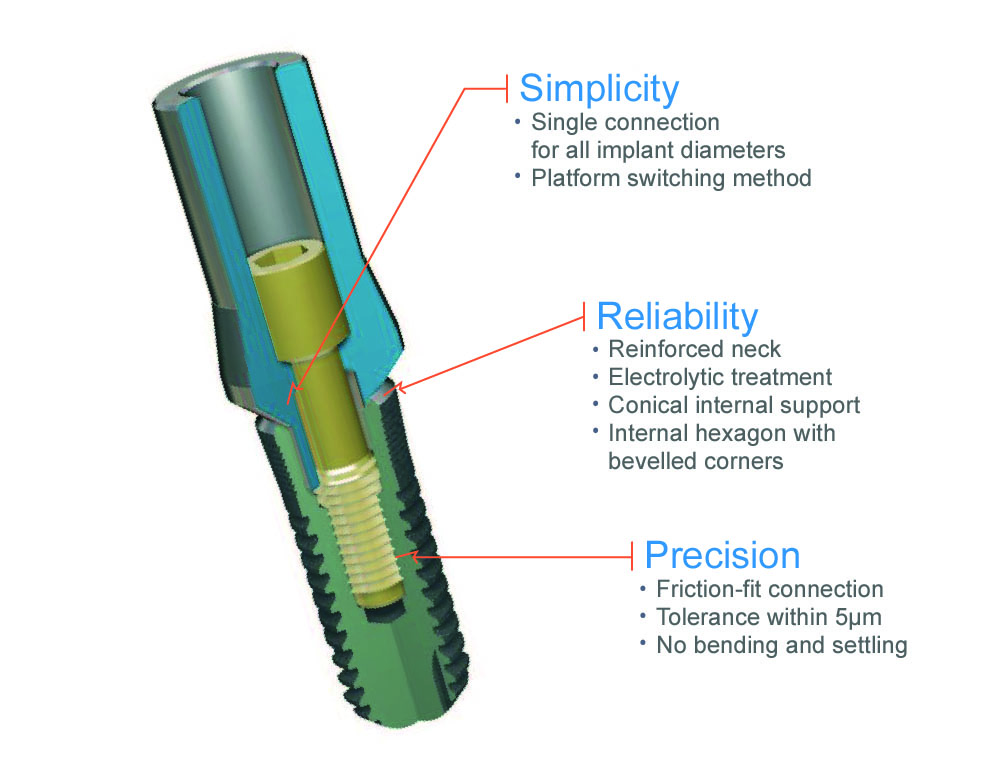The Easy Grip® implant system offers a simple product and a comprehensive range, consisting in threaded implants of cylindrical, anatomical and conical type constructed in titanium grade 5 ELI with diameters 3.30, 3.75, 4.50, 5.00 and 6.00 mm, and lengths varying from 5 to 15 mm which, with the different prosthetic solutions, satisfy the most common implant needs.
The implant system also includes a mini-implant for overdenture (series MBO).
Connection
The connection of the Easy Grip® implant line features a hexagon socket with rounded angles and an internal 45° bevel which increases stability and contributes to assuring correct distribution of forces by discharging the masticatory load evenly across the whole implant diameter.
These conclusions stem from the voluminous research carried out with the Polytechnic University of Marche, entitled “Study and development of fixture/abutment systems in dental implant prosthesis”, available in section “Research” of this website.
This implant connection entails a range of prosthetic solutions, all made with a single standard connection (series3), applicable to all implants in the Easy Grip® line, with integrated platform switching.
Designated prosthetic solution without integrated platform switching are available (series 4 connection) for Large, Extra Large and Extra Extra Large implants.
Since the connection has just 5 μm tolerance (friction fit) the fixture abutment coupling obtained is very steadfast, hence a suitable, easy to use abutment extracting screw (EM) or extracting key (EM2) has been designed and produced. In fact, just screw it in place of the tightening screw to obtain detachment of the prosthetic item from the implant.
For details on connection of implant systems we recommend reading the ISTISAN 07/7 report by the National Institute of Health.

Single connection in Platform Switching
Connection tolerance 5 μm
The Easy Grip® connection system provides locking the fixture/abutment coupling by activating a tightening screw. With this standard method, the tightness of the tightening screw is an essential feature for proper reliability of the implant over time.
Establishing the optimal tightening value of the fixture/abutment connection has always been a critical issue for every implant line.
This value is affected by a range of variables, such as:
• the optimal torque at which to tighten the screw; in the case of the Easy Grip® line this torque has been identified in 35Ncm (see research of the Polytechnic University of Milan)
• the physical-mechanical features of the material which the screw is made of
• the manner and speed at which the screw threading is made
• the screw and connection morphology
The fixture/abutment coupling generates corrosion from titanium friction (fretting) leading to screw settling.
TFI System srl has tackled these issues with cutting edge techniques by using an anodic electrolysis treatment on contact areas in the fixture/abutment coupling which increases resistance to fretting corrosion and raising the deformation limit of its screws to 60 Ncm compared to standard production values which are around 40 Ncm, increasing by 50% the screw’s breaking resistance.
Why choose the Easy Grip® Hex connection?
Because it is simple, reliable, precise

Morphology
The morphological features of the outer threading may be outlined in two aspects:
• Cortical microgrooves
The presence of microgrooves at cortical level means the fixture is snugly seated in the most critical area of the implant/bone interface, preventing the natural postoperative resorption.
The result obtained is:
– optimisation of load distribution, – reduction of stress levels,
– decreased bacterial proliferation.
• Inverted sawtooth threading with double tapping start (for cylindrical and anatomical implants)
It is a type of square threading which provides an optimised surface for transmission of intrusive loads as well as compressive; these loads are about 10 times lower than those occurring on standard (V-threaded) or spur threads.
• Progressive threading
It is a type of square threading that is significantly load bearing on the cervical part of the implant and more pronounced in the apex zone, for targeted bone condensation in the case of D3/D4 type bone insertion.
Morfologia
Le caratteristiche morfologiche della filettatura esterna si possono racchiudere nei seguenti aspetti:
• Microsolchi corticali
La presenza di microsolchi a livello corticale predispone la fixture ad un alloggiamento intimo nella zona più critica dell’interfaccia impianto/osso, prevenendo il naturale riassorbimento post operatorio.
Il risultato che si ottiene è:
– ottimizzazione della distribuzione del carico,
– riduzione dei livelli di stress,
– diminuzione della proliferazione batterica.
• Filettatura a dente di sega rovesciato a doppio principio autofilettante (per impianti cilindrici ed anatomici)
È un tipo di filettatura a spira quadrata che fornisce una superficie ottimizzata per la trasmissione sia dei carichi intrusivi che di quelli compressivi; tali carichi risultano essere circa 10 volte inferiori rispetto a quelli manifestati su spire standard (con filettatura a V) o a sperone.
• Filettatura progressiva
È una filettatura a spira quadrata significativamente portante nella parte cervicale dell’impianto e più pronunciata nella zona apicale per una condensazione ossea mirata nel caso di inserimento in osso di tipo D3/D4.

